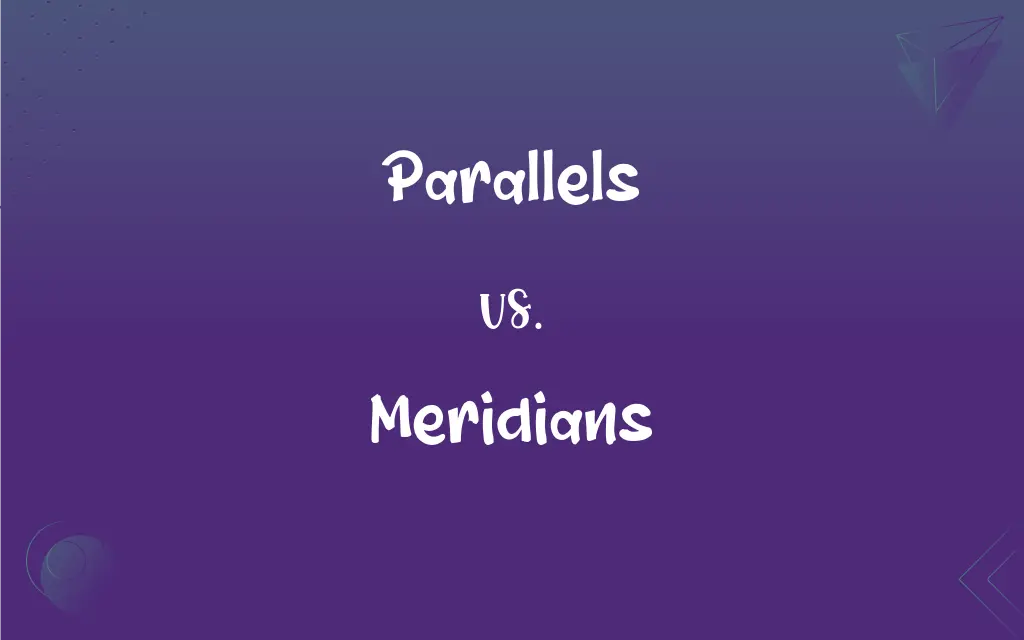Parallels vs. Meridians: What's the Difference?
Edited by Aimie Carlson || By Janet White || Published on February 29, 2024
Parallels are latitude lines circling the Earth horizontally, while meridians are longitude lines running vertically, intersecting at poles.

Key Differences
Parallels, or lines of latitude, run east-west around the globe, equidistant from each other. Meridians, or lines of longitude, run from the North Pole to the South Pole, converging at the poles.
Parallels help in determining the distance north or south of the Equator, measuring angular distance in degrees. Meridians establish the time zones and measure the distance east or west of the Prime Meridian.
Parallels are numbered from 0° at the Equator up to 90° at the poles. Meridians are numbered from 0° at the Prime Meridian, extending to 180° east or west.
Parallels are crucial for climate zones and weather patterns, as they influence the Earth's climatic regions. Meridians aid in navigation and global positioning, essential for maps and GPS technology.
Parallels have been used historically for navigation by sailors, while meridians gained prominence with the establishment of the Prime Meridian at Greenwich in 1884, standardizing global timekeeping.
ADVERTISEMENT
Comparison Chart
Direction
Horizontal around the Earth
Vertical, connecting the poles
Measurement
Degrees north or south of the Equator
Degrees east or west of the Prime Meridian
Primary Use
Determining latitude, climate zones
Determining longitude, time zones
Numbering
From 0° (Equator) to 90° (Poles)
From 0° (Prime Meridian) to 180°
Historical Significance
Navigation by sailors
Establishment of global time zones
ADVERTISEMENT
Parallels and Meridians Definitions
Parallels
An examination of similarities between different entities.
Drawing parallels between two historical events can be enlightening.
Meridians
Pathways in the body along which vital energy flows.
Acupuncture points are often located on body meridians.
Parallels
A line of latitude encircling Earth.
The Tropic of Cancer is an important parallel.
Meridians
A line of longitude running from pole to pole.
The Prime Meridian passes through Greenwich, England.
Parallels
An arrangement of electrical components side by side.
Batteries were connected in parallel to increase capacity.
Meridians
A specific longitudinal line used as a reference.
Many maps before the 19th century did not use the current Prime Meridian.
Parallels
A resemblance or similarity between two things.
Their writing styles bear a striking parallel.
Meridians
The highest or most intense point in time.
His career reached its meridian in the late 90s.
Parallels
Two paths that do not intersect.
The two roads run in parallel through the city.
Meridians
A circle or semicircle representing a meridian on a map.
The meridian on the globe accurately represented Earth's longitudes.
Parallels
Being an equal distance apart everywhere
Dancers in two parallel rows. See Usage Note at absolute.
Meridians
An imaginary great circle on the earth's surface passing through the North and South geographic poles.
Parallels
Of, relating to, or designating two or more straight coplanar lines that do not intersect.
Meridians
Either half of such a great circle from pole to pole. All points on the same meridian have the same longitude.
FAQs
Can parallels and meridians intersect?
Yes, they intersect at right angles, forming a grid on maps.
How do parallels affect climate?
Parallels determine climate zones based on their distance from the Equator.
Do meridians have different widths?
No, meridians converge at poles and are not equidistant like parallels.
What is the significance of the Equator?
The Equator is the largest parallel, dividing Earth into Northern and Southern Hemispheres.
What are meridians?
Meridians are lines of longitude running from pole to pole.
Why are meridians important for timekeeping?
Meridians establish time zones, crucial for global time coordination.
What are parallels?
Parallels are lines of latitude encircling the Earth horizontally.
How are parallels numbered?
Parallels are numbered from 0° at the Equator to 90° at the poles.
Is the Prime Meridian fixed?
The Prime Meridian is a convention, currently fixed at Greenwich, England.
Do parallels change over time?
Parallels remain constant as they are based on Earth's axis.
What's the difference between the Arctic Circle and the Tropic of Cancer?
Both are parallels, but the Arctic Circle is near the North Pole, while the Tropic of Cancer is near the Equator.
Do meridians have any cultural significance?
Yes, in various cultures, meridians have been used for navigation and timekeeping.
How do parallels aid in navigation?
Parallels help determine a location's latitude for navigational purposes.
How do parallels relate to time zones?
Parallels don't directly affect time zones; this is determined by meridians.
Can meridians help in determining local time?
Yes, local time is calculated based on the position relative to the nearest meridian.
Are there any parallels at the poles?
The poles themselves are points where all parallels converge.
Are there famous meridians besides the Prime Meridian?
The International Date Line is another significant meridian.
What is the role of meridians in GPS?
Meridians help in pinpointing precise longitudinal coordinates in GPS systems.
Is the Prime Meridian the only zero-degree meridian?
Yes, it is internationally recognized as the zero-degree longitudinal line.
Are parallels used in modern technology?
Yes, parallels are integral in mapping, navigation systems, and climate studies.
About Author
Written by
Janet WhiteJanet White has been an esteemed writer and blogger for Difference Wiki. Holding a Master's degree in Science and Medical Journalism from the prestigious Boston University, she has consistently demonstrated her expertise and passion for her field. When she's not immersed in her work, Janet relishes her time exercising, delving into a good book, and cherishing moments with friends and family.
Edited by
Aimie CarlsonAimie Carlson, holding a master's degree in English literature, is a fervent English language enthusiast. She lends her writing talents to Difference Wiki, a prominent website that specializes in comparisons, offering readers insightful analyses that both captivate and inform.






































































